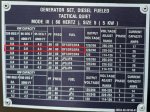My first generator was a 802a I snagged off CL for $800. It's older, a 1994 model, but low hours (221 hrs) and decent shape for its age.
However, its always been slightly down on power and based on cold start, full load performance, blowby, etc, I would guess it's lost some compression. My first thought was stuck rings, but I was curious if there was an outward of determining stuck rings from broken rings?
Honestly, it's probably fine being a backup unit, but it would be great to get it in top running condition.
However, its always been slightly down on power and based on cold start, full load performance, blowby, etc, I would guess it's lost some compression. My first thought was stuck rings, but I was curious if there was an outward of determining stuck rings from broken rings?
Honestly, it's probably fine being a backup unit, but it would be great to get it in top running condition.



